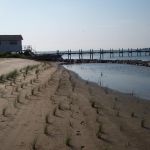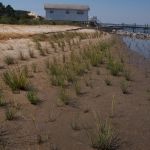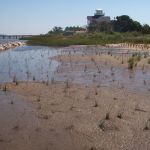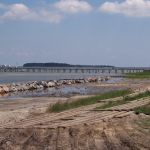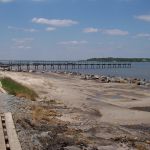Bostic Property, Harkers Island
Description
In addition to the habitat and water quality functions provided by the restored and stabilized shoreline, the site provides demonstration of alternative shoreline stabilization techniques, in combination with oyster/marsh restoration areas. This demonstration is a valuable tool in educating property owners, as well as regulatory agencies, legislators, etc. about the benefits and efficacy of these approaches in coastal North Carolina.
The greatest challenges that were encountered in this project involved an unusually high level of mortality of the first 5,000 marsh plants that were planted during in May 2004. As a result of the plant mortality and the effects of a northeast storm during this period, another 2,000 plants were planted in August 2004, and 6,000 plants were replanted during April and May of 2005.
The Bostic project has implications for estuarine living resources, as well as for policy and water quality purposes. Coastal marsh is prime habitat for fish-rearing, supporting numerous recreational and commercially valuable species. In addition, structures such as this sill and restored marsh emplaced along the restored shorelines will provide oyster habitat. Oysters and oyster habitat provide direct benefits to estuarine and ocean coastal fisheries. Restored oyster reefs and populations provide critical bottom habitat for numerous fish species, as well as important macrofaunal species which use shell bottom as spawning and/or nursery areas. In addition to direct benefits to living marine species, restored marsh and oyster habitats provide valuable water quality benefits to estuarine waters, through the pollution uptake, stormwater buffering, and nutrient uptake abilities of coastal marshes, and filtering capabilities attributed to oysters.
Technical Details
The Harkers Island Community-based Restoration Program consists of restoration of 410 linear feet of estuarine shoreline and stabilization of roughly 4 acres of eroding coastal marsh. Stone sill was constructed along the 410 feet of estuarine shoreline and sandy fill was used to plant 2 feet by 2 feet grids of native tidal species, Spartina alterniflora and Spartina patens.
Funding
The project was funded in part by a grant from the National Oceanic and Atmospheric Administration’s Community-based Restoration Program. Matching contributions were provided by North Carolina Coastal Federation.
NOAA grant: $33,756
NCCF: $36,140
Total Project Expenses: $69,896
